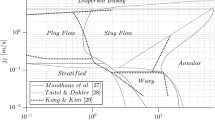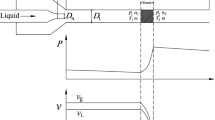The influence of the phase transitions in gas–liquid flows on the accuracy of reproduction of the discharge of gas–liquid mixtures under high pressures on test benches is analyzed. An algorithm for the numerical analysis of the phase equilibrium of mixtures of air with various concentrations of an Exxol oil substitute is developed with the use of the equations of state and the fundamental concepts of thermodynamics. The coefficients of binary interaction of the Exxol oil substitute and the main components of air (nitrogen, carbon dioxide, oxygen, and argon) are obtained. The experimental data and numerical results on the saturation of Exxol–air mixtures are presented for various concentrations. It is shown that if we neglect the phase transitions, then the information about the parameters of multiphase flows measured on testing benches becomes significantly distorted.


Similar content being viewed by others
References
GOST 8.637–2013, GSI. State Accuracy Chart for Instruments Measuring Multiphase Flows, Izd. Standartov, Moscow (2013).
A. Danesh, PVT and Phase Behaviour of Petroleum Reservoir Liquids, Elsevier, Amsterdam (1998).
A. I. Brusilovskii, Phase Transformations in the Development of Oil and Gas Deposits, Graal’, Moscow (2002).
J. O. Valderrama and L. A. Cisternas, “A cubic equation of state for polar and other complex mixtures,” Fluid Phase Equil., 29, 431–438 (1986).
M. I. Tonkonog, K. A. Levin, and I. I. Fishman, “Analysis of methods for the determination of the coefficients taking into account the presence of gas dissolved in oil,” Izmer. Tekhn., No. 10, 60–65 (2016).
J. M. Prausnitz, R. N. Lichtenthaler, and E. G. de Azevedo, Molecular Thermodynamics of Fluid-Phase Equilibria, Prentice-Hall, Englewood Cliffs, NJ (1986), 2nd ed.
M. L. Michelsen, “Calculation of phase envelopes and critical points for multicomponent mixtures,” Fluid Phase Equil., 4, Nos. 1–2, 1–10 (1980).
K. S. Pedersen and P. L. Christensen, Phase Behavior of Petroleum Reservoir Fluids, CRC Press, Boca Raton (2007).
D.-H. Xu, A. Danesh, and A. C. Todd, “An accelerated successive substitution method for calculation of saturation pressure of multicomponent fluids,” Fluid Phase Equil., 72, 15–24 (1992).
G. A. Wilson, “Modified Redlich–Kwong EOS, application to general physical data calculations,” AIChE 65th Nat. Meeting, Cleveland, Ohio (1968).
C. H. Twu, “An internally consistent correlation for predicting the critical properties and molecular weights of petroleum and coal tar liquids,” Fluid Phase Equil., 16, 137–150 (1984).
B. I. Lee and M. G. Kesler, “A generalized thermodynamic correlation based on three-parameter corresponding states,” AIChE J., 21, No. 3, 510–527 (1975).
R. C. Reid, J. M. Prausnitz, and T. K. Sherwood, Properties of Gases and Liquids, McGraw-Hill, New York (1977).
P. L. Chueh and J. M. Prausnitz, “Vapour-liquid equilibria at high pressures, calculation of partial molar volume in nonpolar liquid mixtures,” AIChE J., 13, No. 6, 1099–1113 (1967).
D. Marquardt, “An algorithm for least-squares estimation of nonlinear parameters,” SIAM J. Appl. Math.. 11. No. 2, 431–441 (1963).
Author information
Authors and Affiliations
Corresponding author
Additional information
Translated from Izmeritel’naya Tekhnika, No. 11, pp. 36–41, November, 2017.
Rights and permissions
About this article
Cite this article
Tonkonog, M.I., Levin, K.A., Shabalin, A.S. et al. Analysis of the Role of Phase Transformations in the Reproduction of Gas–Liquid Flows is a Possibility to Improve the Standards of Discharge for Multiphase Flows. Meas Tech 60, 1122–1129 (2018). https://doi.org/10.1007/s11018-018-1328-2
Received:
Published:
Issue Date:
DOI: https://doi.org/10.1007/s11018-018-1328-2




